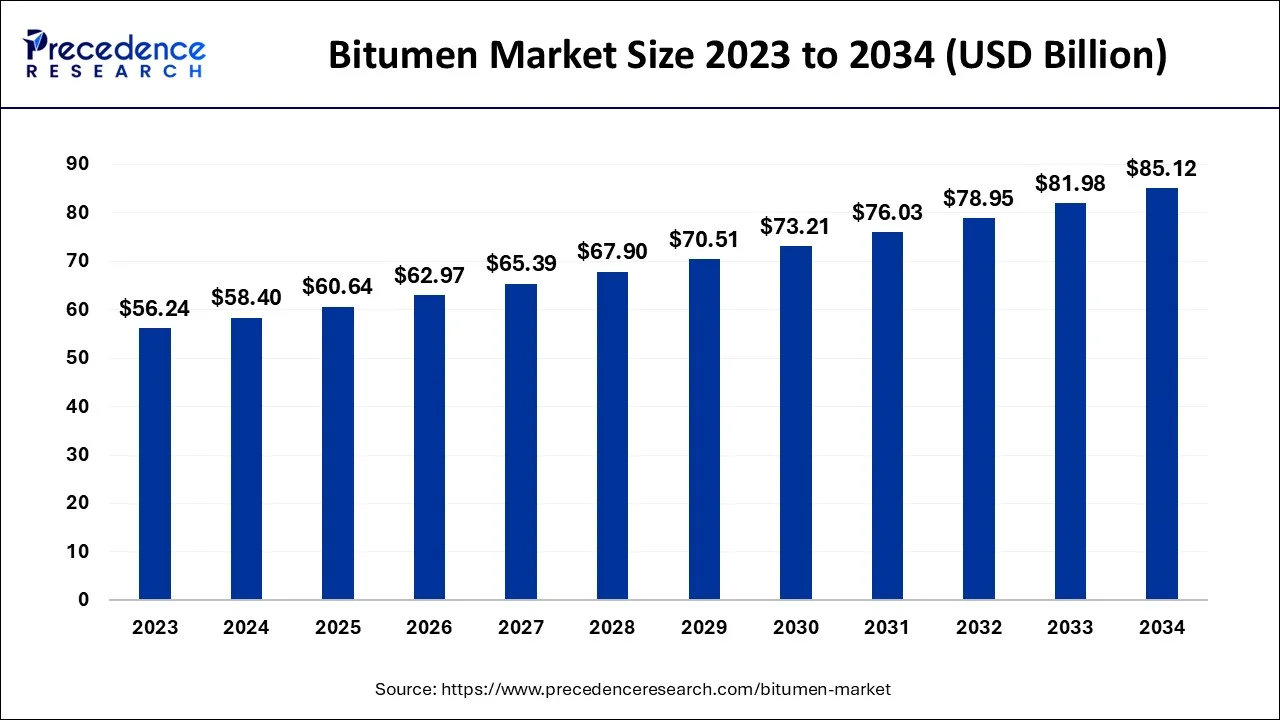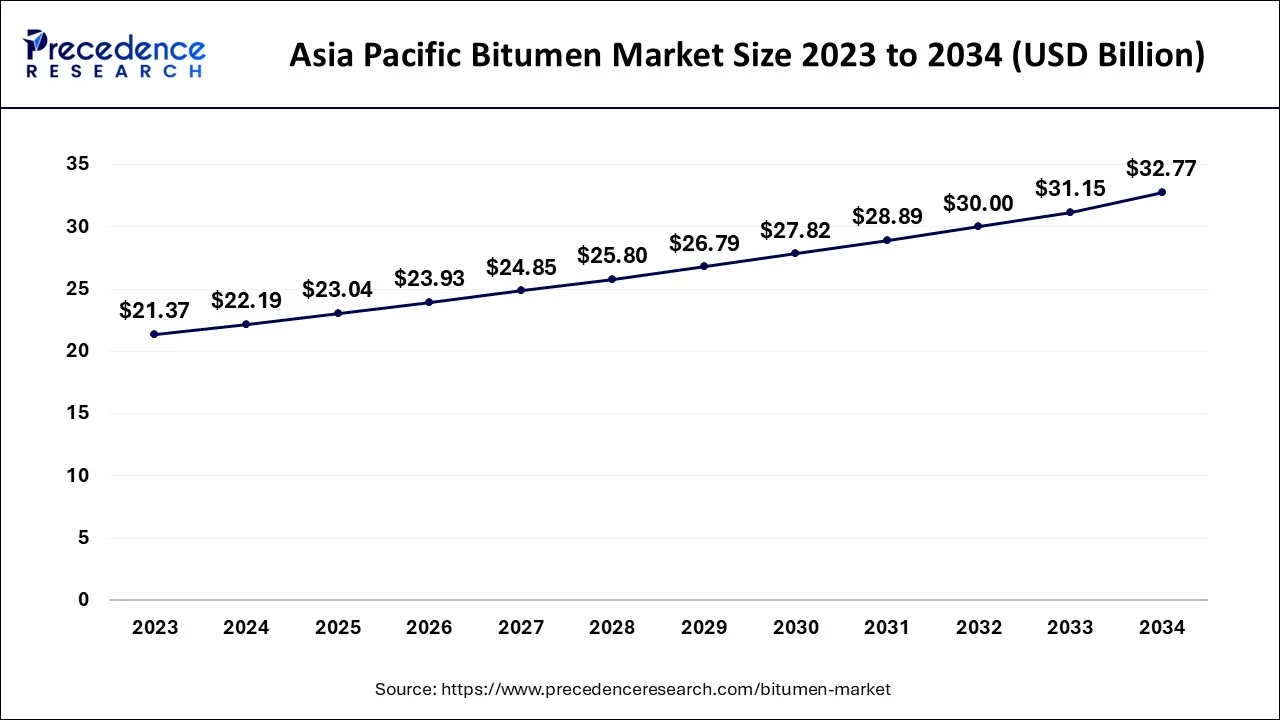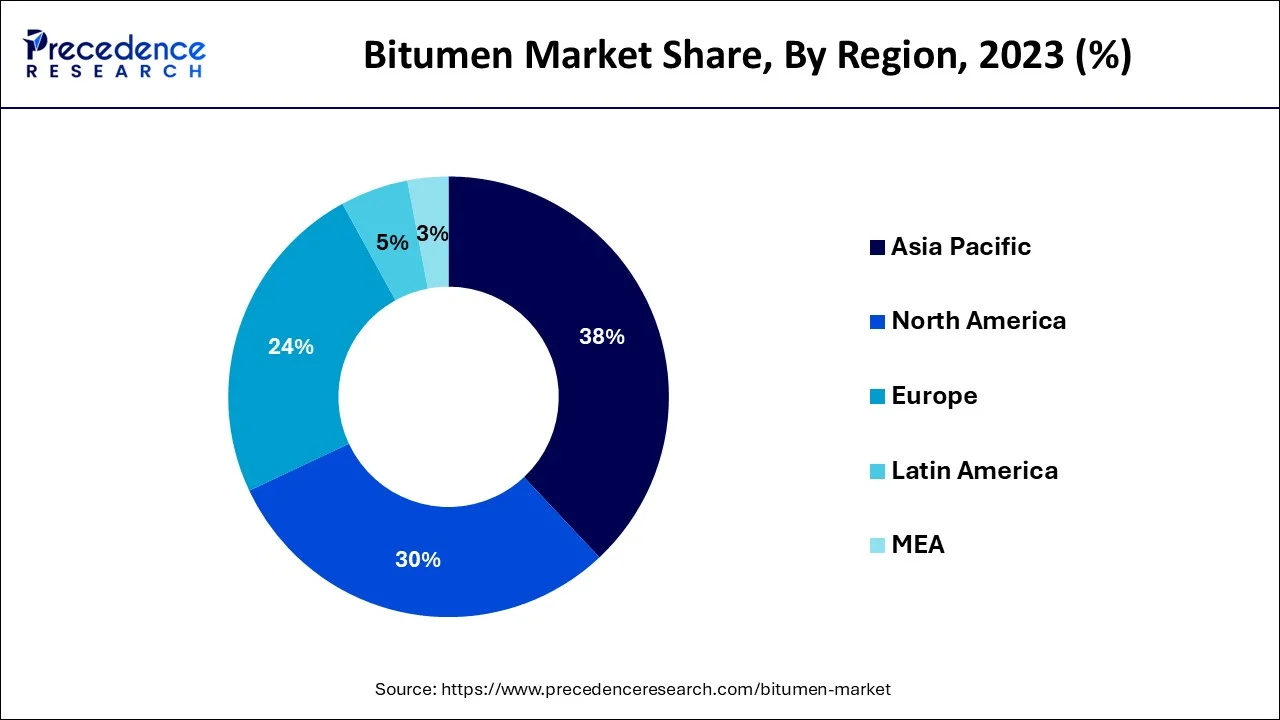The global bitumen market size accounted for USD 58.40 billion in 2024, grew to USD 60.64 billion in 2025 and is predicted to surpass around USD 85.12 billion by 2034, representing a healthy CAGR of 3.84% between 2024 and 2034.
The global bitumen market size is estimated at USD 58.40 billion in 2024 and is anticipated to reach around USD 85.12 billion by 2034, expanding at a CAGR of 3.84% from 2024 to 2034.

The Asia Pacific bitumen market size is estimated at USD 22.19 billion in 2024 and is expected to be worth around USD 32.77 billion by 2034, rising at a CAGR of 3.96 from 2024 to 2034.

Due to the expanding use of bitumen compounds in several industries, Asia Pacific will surpass in 2032. Due to the rising automotive penetration and regional development, the highway and road construction sector in APAC nations like India, China, and Australia has been expanding quickly. The country's increase in passenger and freight motor traffic, followed by manufacturers, would further encourage road construction. The country's bituminous industry revenue has also been greatly impacted by expanding investments in manufacturing industries. Due to significant road network-building measures implemented by the Government for India within North India Area, including federal highways developments in Uttar Pradesh & Punjab, North India represented the majority of the India bitumen share of the market in 2023.

Additionally, it is anticipated that the upkeep and repair of rural roads built under The Pradhan Mantri Gram Sadak Yojana in the states of Haryana, Uttarakhand, Rajasthan, and Himachal Pradesh will increase the demand for bitumen in each of these regions, propelling the expansion of the bitumen industry in Northern India. Due to an increase in road-building development operations across the nation in 2021, the pavement quality bitumen sector was responsible for the majority of sales. Bitumen content’s need is driven by federal initiatives like Bharatmala, numerous national road constructions, and the development of various special economic zones throughout several states. Additionally, the Legislature of India's programs to build rural roads, including the Pradhan Mantri Gram Sadak Yojana, as well as to upgrade, maintain, and repair existing country roads, major roads, and major highways, are expected to increase demand for bitumen throughout India and propel the expansion of the country's bitumen industry.
Bitumen sometimes referred to as asphalt, is a naturally occurring or petroleum distillation-derived black, sticky mixture of hydrocarbons. It is sprayed as glue and combined with fine aggregates to create concrete blocks in a variety of applications, including road building. Other uses for waterproof goods include the creation of insulation, adhesives, and roofing felt. Because of its high viscous, adhesion, and moisture qualities, bitumen is a crucial raw material in the architectural & manufacturing industries for making water dams, tanks, and bridges. During the coming years, bitumen share of the market will be driven by rising government spending and legislation towards roads and infrastructure development employing Publicly Owned Collaboration models throughout industrialized and emerging countries. They contribute to the greater use of bituminous materials in the construction and maintenance of roads. The establishment of new manufacturing units and expanding infrastructure in emerging regions are favorable to the demand for the products. One of the things boosting the development of a bitumen industry is the fact that bitumen is utilized in paints and coatings, dyes & pigments, and other industries because of its features like waterproofing & thickness.
The expansion of the roadway & construction projects industries is a primary driver of the bitumen market's expansion in India. The building of several motorways or airport runways increases the need for bitumen throughout the nation. Asphalt is created by processing bitumen for highway construction. The State Road Transport Development Company, the six-landing of congested stretches of both the Heavenly Equilateral triangles, a special software package for the improvement of road connectedness in Naxal-affected areas, the advancement of Visakhapatnam Ranchi Route, and efforts to provide last-mile connectivity are additional projects that are expected to increase govt investment in the construction of national highways and expressways. In addition, bitumen is frequently used for roofing in the construction sector due to its physical characteristics, including stickiness, waterproofing, toughness, flexibility, and increased elastic modulus. As a result, the need for bitumen increased across the nation as a result of expansion in the building industry because of a rise in the urban population and a need for new homes. Additionally, government programs like the Pradhan Awas Yojana, which involves building homes for low-income individuals residing in both urban and rural areas, are projected to raise the need for bitumen, fuelling the expansion of the Indian bitumen industry. However, bitumen-related environmental and human health concerns are shifting crude oil prices globally. The market's growth is anticipated to be constrained by the rising use of bitumen substitutes such as cement in an application involving the construction of roads. Additionally, it is projected that the introduction of bio-based bitumen with an EME binder would offer the profit potential for the industry's continued growth.
| Report Coverage | Details |
| Market Size in 2024 | USD 58.40 Billion |
| Market Size by 2034 | USD 85.12 Billion |
| Growth Rate from 2024 to 2034 | CAGR of 3.84% |
| Base Year | 2023 |
| Forecast Period | 2024 to 2034 |
| Segments Covered |
|
| Regions Covered |
|
In terms of value, pavement bitumen will control close to 61% of the market by 2033. Due to its durability and quick repairability, asphalt concrete is utilized as the binder with around 86% of all bitumen produced for roads, parking lots, asphalt, & footpaths. A Paving quality bitumen with a bitumen percentage of 65–75% is produced through meticulously controlled refining processes employing properly selected crude oils. To create concrete blocks, coarse and fine materials, including pebbles or crushed rock, must be combined with asphalt, which serves as the binder material.
The demand for highway building will significantly increase in the next years due to the increasing number of automobiles in the world, particularly in the expanding countries of North America & Asia Pacific. Bitumen's marketplace worth will increase because of its widespread accessibility and inexpensive cost on the road of building projects all over the world. Because of its many uses, the market for bitumen used in paving is anticipated to increase at a 4.07 CAGR during the forecast period.
The highways usage segment held the largest share and produced the most money in 2023. Bitumen was most commonly employed in highway construction, where it serves as binding for the production of asphalt pavement Platforms. This section discusses using bitumen to build new roadways and pave existing ones, including overflights, freeways, and airport runways. The need for a larger highway and road infrastructure with numerous tracks to facilitate all vehicles throughout peak times would emerge from an increase in vehicular traffic around the world caused by rising Purchasing power Equality in emerging nations. The urbanization process and industrialization will also improve rural and urban areas' connectivity, increasing the need for road construction projects.
By Product
By Application
By Geography
For inquiries regarding discounts, bulk purchases, or customization requests, please contact us at sales@precedenceresearch.com
No cookie-cutter, only authentic analysis – take the 1st step to become a Precedence Research client